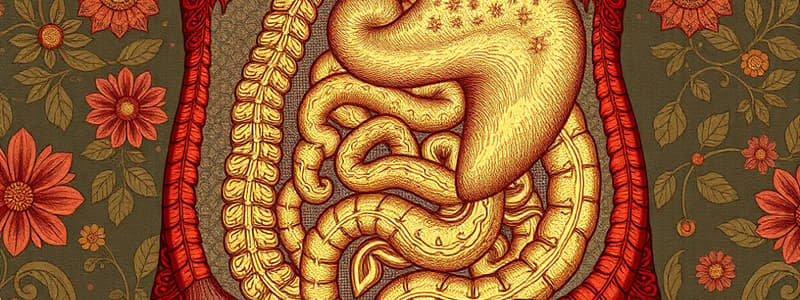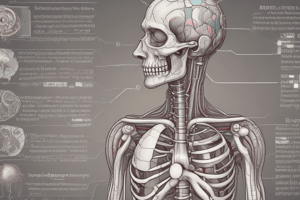Podcast
Questions and Answers
Which of the following is the primary function of saliva in the mouth cavity?
Which of the following is the primary function of saliva in the mouth cavity?
- To produce bile for lipid emulsification.
- To dissolve food for tasting and begin starch digestion. (correct)
- To secrete intestinal juice containing enzymes.
- To aid in mechanical digestion through churning.
What is the role of the pyloric sphincter in the digestive system?
What is the role of the pyloric sphincter in the digestive system?
- To regulate the flow of material from the stomach to the duodenum. (correct)
- To carry food from the mouth to the stomach.
- To produce pancreatic juice for digesting proteins, lipids, and nucleic acids.
- To emulsify lipids in the small intestine.
How does the liver contribute to the digestive process?
How does the liver contribute to the digestive process?
- By secreting intestinal juice to break down various nutrients.
- By producing bile, which emulsifies lipids in the small intestine. (correct)
- By producing saliva that aids in the digestion of starch.
- By storing and releasing bile into the duodenum to digest proteins.
Which section of the digestive system is primarily responsible for the absorption of water, minerals, and vitamins?
Which section of the digestive system is primarily responsible for the absorption of water, minerals, and vitamins?
What enzymes are contained in the pancreatic juice produced by the pancreas?
What enzymes are contained in the pancreatic juice produced by the pancreas?
What is the function of the villi in the small intestine?
What is the function of the villi in the small intestine?
In infants, what is the role of rennin produced in the stomach?
In infants, what is the role of rennin produced in the stomach?
What is the function of the appendix in the digestive system?
What is the function of the appendix in the digestive system?
Which of the following describes the oesophagus' primary role in digestion?
Which of the following describes the oesophagus' primary role in digestion?
Where does the digestion of proteins primarily begin?
Where does the digestion of proteins primarily begin?
Flashcards
Mouth Cavity
Mouth Cavity
Mechanical digestion by teeth; chemical digestion of starch by saliva.
Salivary Glands
Salivary Glands
Three pairs of glands producing saliva that dissolves food; contains salivary amylase to begin starch digestion.
Oesophagus
Oesophagus
Carries food from the mouth to the stomach, passing through the diaphragm.
Liver
Liver
Signup and view all the flashcards
Gall Bladder
Gall Bladder
Signup and view all the flashcards
Duodenum
Duodenum
Signup and view all the flashcards
Pancreas
Pancreas
Signup and view all the flashcards
Small Intestine
Small Intestine
Signup and view all the flashcards
Colon
Colon
Signup and view all the flashcards
Rectum
Rectum
Signup and view all the flashcards
Study Notes
- The alimentary canal and associated organs form the digestive system.
- The lining of the alimentary canal facilitates nutrient absorption.
Mouth Cavity
- Mechanical digestion occurs via teeth.
- Chemical digestion of starch begins with saliva.
Salivary Glands
- Three pairs of glands produce saliva.
- Saliva dissolves food allowing it to be tasted.
- Mucus in saliva lubricates the mouth and food, forming a bolus for swallowing.
- Saliva contains salivary amylase, an enzyme that initiates starch digestion.
Pharynx
- The tongue pushes food into the pharynx for swallowing.
- The pharynx is located at the back of the mouth cavity
Oesophagus
- Transports food from the mouth to the stomach.
- It passes through the diaphragm into the abdominal cavity.
Liver
- Produces bile, which emulsifies lipids in the small intestine.
- Bile is stored and concentrated in the gall bladder.
Gall Bladder
- Stores and releases bile into the small intestine.
- Bile emulsifies lipids.
Stomach
- Mechanical digestion occurs through churning.
- Chemical digestion is initiated by pepsin, which begins protein digestion.
- In infants, rennin coagulates milk protein.
Duodenum
- The first part of the small intestine.
Pyloric Sphincter
- A band of circular muscle which regulates the flow of material from the stomach to the duodenum.
Pancreas
- Produces pancreatic juice.
- Pancreatic juice contains enzymes which digest proteins, lipids and nucleic acids.
Small Intestine
- Approximately 6 meters long.
- The lining secretes intestinal juice which contains many enzymes.
- The internal surface is lined with villi for absorption of digested food.
Transverse, Ascending and Descending Colon
- These components comprise the longest part of the large intestine.
- Absorption of water, minerals, and vitamins occurs here.
Caecum
- The first part of the large intestine.
Appendix
- Plays a role in immunity.
- Stores useful bacteria.
Rectum
- The final part of the large intestine.
- Faeces are formed here.
Anus
- An opening surrounded by the anal sphincter.
- The anal sphincter is a muscle that can be voluntarily controlled.
Studying That Suits You
Use AI to generate personalized quizzes and flashcards to suit your learning preferences.




